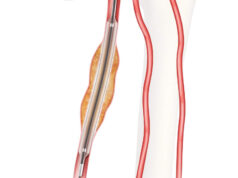Fluoroquinolones—one of the most commonly prescribed antibiotic classes in the United States—were associated with increased incidence of aortic aneurysm formation in U.S. adults, a new study published in JAMA (Journal of the American Medical Association) Surgery found.
“This association was consistent across adults aged 35 years or older, sex, and comorbidities, suggesting fluoroquinolone use should be pursued with caution in all adults, not just in high-risk individuals,” authors Emily R. Newton, MD, of the department of surgery at the University of North Carolina at Chapel Hill et al conclude.
The researchers point to recent studies probing the safety of fluoroquinolones among patients in Taiwan, Sweden and Canada—and a paucity of data assessing the U.S. population and the true extent of what defines those at highest risk. A Food and Drug Administration (FDA) warning was updated in 2018 to include that fluoroquinolone use in high-risk populations should be limited, they wrote. “Recent international studies have called into question the safety of this class of antibiotics, with reports showing a possible association with acute aortic aneurysm and dissection development,” they add.
Despite such studies and warnings, fluoroquinolones remain the most commonly prescribed antibiotic in long-term care facilities, suggesting minimal practice change, the investigators continue.
Newton and colleagues identified prescription fills for fluoroquinolones or a comparator antibiotic from 2005–2017 among commercially insured individuals aged 18–64 years in a retrospective analysis of MarketScan health insurance claims. The study included nearly 28 million U.S. adults—or 47.5 million antibiotic episodes—with no known previous aortic aneurysm or dissection, no recent antibiotic exposure and no recent hospitalization. The primary outcome was 90-day incidence of aneurysm and aortic dissection per 10,000 antibiotic fills.
Of 47.5 million fills, 9 million (19%) were fluoroquinolones. The median of those with fluoroquinolone fills was 47 vs. 43 with comparator antibiotic fills. Women comprised 61.3% of fluoroquinolone fills and 59.5% of comparator antibiotic fills, the researchers found. Before weighting, the 90-day incidence of newly diagnosed aneurysm was 7.5 cases per 10,000 after fluoroquinolones compared with 4.6 cases in the case of comparator antibiotics. After weighting for demographic characteristics and comorbidities, fluoroquinolone fills were associated with increased incidence of aneurysm formation (hazard ratio [HR], 1.20; 95% confidence interval [CI] 1.17–1.24).
“More specifically, compared with comparator antibiotics, fluoroquinolone fills were associated with increased 90-day incidence of abdominal aortic aneurysm (HR, 1.31; 95% CI, 1.25–1.37), iliac artery aneurysm (HR, 1.60; 95% CI, 1.33–1.91), and other abdominal aneurysm (HR, 1.58; 95% CI, 1.39–1.79), and adults were more likely to undergo aneurysm repair (HR, 1.88; 95% CI, 1.44–2.46),” Newton and colleagues write.
Furthermore, the investigators found that when stratified by age, all adults 35 years or older appeared at increased risk, they demonstrate—18–34 years: HR, 0.99 [95% CI, 0.83–1.18]; 35–49 years: HR, 1.18 [95% CI, 1.09–1.28]; 50–64 years: HR, 1.24 [95% CI, 1.19–1.28]; p=0.04).
In an associated invited commentary on the study, Amanda C. Filiberto, MD, a general surgery resident at the University of Florida in Gainesville, and Gilbert R. Upchurch Jr., MD, the same institution’s chair in the department of surgery, observed that though contradictory studies have been published recently, “this large cohort study of a U.S. population suggests it is time once again to rethink the use of this class of antibiotics for patients with or without aortic disease.”
Concluding, the research team write that “fluoroquinolone use in the U.S. and internationally has been associated with an increase in immediate incidence of aortic aneurysm formation.”
They continue: “Although the overall incidence of aneurysm formation detected in the present study was low, the aneurysm incidence after a fluoroquinolone fill was 20% higher than that of comparator antibiotics, and consistent among all adults age 35 years or older. When examining specific anatomic sites, there was a 31% higher incidence of abdominal aortic aneurysm and a 60% higher incidence of iliac artery aneurysm after fluoroquinolone use.”
The authors believe that “contextualizing these data,” the current FDA black box warnings are warranted “but may need to be expanded to include younger adults with other risk factors.”
SOURCE: doi:10.1001/jamasurg.2020.6165












